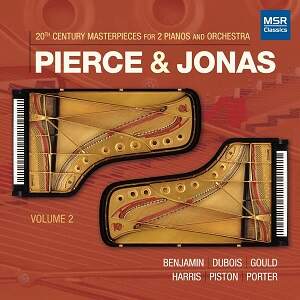
Twentieth Century Masterpieces for 2 Pianos and Orchestra – Volume 2
Pierre Max Dubois (1930-1995)
Concerto Italien for two pianos and orchestra (1962)
Roy Harris (1898-1979)
Concerto for two pianos and orchestra (1946)
Arthur Benjamin (1893-1960)
North American Square Dance Suite for two pianos and orchestra (1950)
Walter Piston (1894-1976)
Concerto for two pianos and orchestra (1959)
Quincy Porter (1897-1966)
Concerto Concertante for two pianos and orchestra (1952)
Morton Gould (1913-1996)
Dance Variations for two pianos and orchestra (1952)
Joshua Pierce, Dorothy Jonas (pianos)
Slovak Radio and Television Symphony Orchestra/Kirk Trevor
Royal Philharmonic Orchestra, Philharmonic Society of Moravia/David Amos
rec. 1989-2001, Czechia, Slovakia and London
MSR Classics MS1652 [2 CDs: 114]
Received wisdom almost dictates the ‘luxury’ of dividing commerce from art. When it comes to commercial activity (or public funding for that matter) lulling musical sargassos or maelstroms can raise wheals as well as dollars. Let’s leave aside that artists need to be able to survive or thrive and may have family to feed. As it turns out, where the two contestants meet, as in the present case, and while funding bodes can bask in prestige or tax reliefs, the lowly listener manifestly benefits. Look at these recordings of works reissued in handsome uniformity. The very same commercially sullied world has brought these discs – there is an earlier MSR pairing – forward several times over the years. This has been accomplished through an ‘honour parade’ of smaller labels (Kleos, Helicon, Centaur). It’s very encouraging and rewarding to see and hear these recordings again and all in one welcoming place. In the present case, the music, written between 1946 and 1959, still has the freshness of discovery and the freshness of experience about it.
The present MSR Classics set is largely a North American two-piano and orchestra fest. Exceptions are the Dubois (French) and the Benjamin (Australian). The latter, a brilliant composer and executant musician, honed his art, career and colourful life in England and the Pacific coast of America. The Benjamin happens to make national ‘compensation’ by choosing raw material which is American. Dubois – born in the Tarn département – was a pupil of Jean Doyen and Darius Milhaud. He wrote much on a small-scale but there are also two concertos for saxophone and much else for the instrument. His Concerto Italien is nervily active, sparkling, not especially jazzy and with a dash of romance. In the Andante and elsewhere Dubois is not a stranger to romantic inclination and to gently nestled melancholy.
Like the Dubois, the Roy Harris is in three movements. Here, as we should expect, the composer conveys epic character admixed with brilliance. As I have noted previously his “trademark transitions from dramatic declamation to whispered string gesture and rapid insistent thunderous repartee are much in evidence”. Wide horizons and catastrophe straddle the central Theme and Variations,offset by delicately gentle musing. Those already captivated by Harris’s symphonic manner will want to spend time with the finale in which orchestra and soloists surefootedly immerse themselves.
Victor Vronsky and Vitya Babin were the dedicatees of the Benjamin work which is in eight super-short movements. It must be said that this is not Benjamin at his greatest …. and he can be great. The music is sentimental and even kitschy. Even in works he ‘wrote’ as arrangements – the gorgeous but stylistically alien oboe concerto arrangements for Evelyn Barbirolli and others – he could probe deeper than this. This is music that does not pretend to the global turbulence and tragic-heroism of the Symphony, Violin Concerto, Ballade and Viola Sonata. Even so this is a good account though, if you want a contrast with very difference couplings, go for Tintner on Naxos or, best of all if you can get to hear it, the superlative 1983 broadcast by the BBC Concert Orchestra with Barry Wordsworth.
The second disc is Americana unalloyed, allowing for its universe being, in any event, a melting pot. The three-movement Piston is a big, blurty, refreshingly flamboyant and hearty Piano Concerto. It is redolent of the catchy dance elements of his Second Symphony, which always strikes me as the best of his eight. The Second is a work that long predates this concerto but is tuneful and easy to listen to. Nor does the Concerto lose its way in neo-baroque ineffectual vacuousness. It was commissioned by and dedicated to Melvin Stecher and Norman Horowitz.
Quincy Porter’s single-movement, 14-section Concertante is in a more oblique style than the Piston and is even a touch moodily subtle. Commissioned by the Louisville Orchestra, that great engine in the 1950s and 1960s of new music on the international stage, it was written whilst the composer was living in Florence. The compact Concertante garnered Porter a Pulitzer Prize and here is played in what feels like a very natural and fluent style.
The Dance Variations by Morton Gould is in four movements. It is a shade more subtle and tougher than some Gould works – for example the queasy Symphonettes. Even so, it is an example of populist writing out of the same broad and vivid colouring book as piano and orchestra works by Tavares, Marx, Respighi, Palmgren, Albeniz and John Carmichael. Gould takes up a garish brush but keeps the popular elements – Cuban nights and waterfront – in balance with greater subtlety such as can be heard in the very dreamy tender Pas de Deux tango.
The booklet notes, in English only, are nothing short of splendid and there are apposite photographs as well. The sound throughout is good and pianists Pierce and Jonas (and their orchestras and conductors from hither and yon) are owed more than thanks for their part in bringing these works to our ears with sparkle and emotional lightning undimmed.
Rob Barnett
Help us financially by purchasing from




















